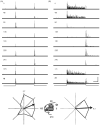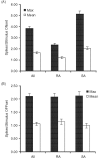Response properties of mouse trigeminal ganglion neurons
- PMID: 18989828
- PMCID: PMC2597100
- DOI: 10.1080/08990220802467612
Response properties of mouse trigeminal ganglion neurons
Abstract
We used controlled whisker deflections to examine the response properties of 208 primary afferent neurons in the trigeminal ganglion of adult mice. Proportions of rapidly adapting (RA, 47%) and slowly adapting (SA, 53%) neurons were equivalent, and most cells had low or no spontaneous activity. We quantified angular tuning and sensitivity to deflection amplitude and velocity. Both RA and SA units fired more frequently to larger deflections and faster deflections, but RA units were more sensitive to differences in velocity whereas SA units were more sensitive to deflection amplitudes. Almost all neurons were tuned for deflection angle, and the average response to the maximally effective direction was more than fourfold greater than the average response in the opposite direction; SA units were more tuned than RA units. Responses of primary afferent whisker-responsive neurons are qualitatively similar to those of the rat. However, average firing rates of both RA and SA neurons in the mouse are less sensitive to differences in deflection velocity, and RA units, unlike those in the rat, display amplitude sensitivity. Subtle observed differences between mice and rats may reflect greater mechanical compliance in mice of the whisker hairs and of the tissue in which they are embedded.
Figures






References
-
- Berger T, Borgdorff A, Crochet S, Neubauer FB, Lefort S, Fauvet B, Ferezou I, Carleton A, Luscher HR, Petersen CC. Combined voltage and calcium epifluorescence imaging in vitro and in vivo reveals subthreshold and suprathreshold dynamics of mouse barrel cortex. J Neurophysiol. 2007;97:3751–3762. - PubMed
-
- Brecht M, Preilowski B, Merzenich MM. Functional architecture of the mystacial vibrissae. Behav Brain Res. 1997;84:81–97. - PubMed
-
- Carvell GE, Simons DJ. Task- and subject-related differences in sensorimotor behavior during active touch. Somatosens Mot Res. 1995;12:1–9. - PubMed
Publication types
MeSH terms
Grants and funding
LinkOut - more resources
Full Text Sources
